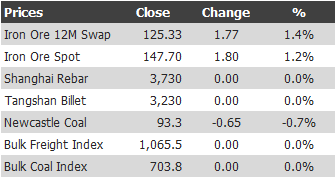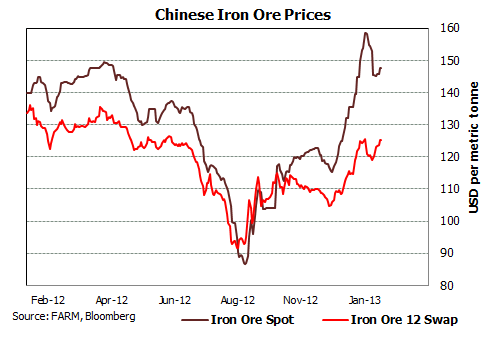Here is the iron ore price table for January 23, 2013:

And the iron ore price chart:

Of note is the push by 12 month swaps towards a new high for the move, just 30 cents shy. Such would signal the recent correction over.
In news today, there is a red hot investigative story from CaixinOnline. It’s longish but is a great read if you want to understand what I’ve been banging on about vis-a-vis the vital role of speculators and hoarders in the iron ore market:
Prices for imported iron ore got quite a workout in 2012.
The price soared from less than US$ 90 per ton in September to US$ 155 per ton in January. In December alone, it rose nearly US$ 40.
“I felt deeply that iron ore prices are elusive and hard to judge,” Liu Ming, an executive involved in a raw material purchasing at a medium-sized steel mill in eastern China, said.
“This round of rising prices especially cannot be explained by supply and demand or macroeconomic conditions.”
…”Look at the crude steel data,” an official who deals in raw materials for a large steel firm in Shanghai said. “You will know if real demand increased.”
This round of price increases simply were not reflected by real demand, said Liu Haimin, deputy director of the government-backed Metallurgical Economic Research & Development Center (MERDC), said. Liu said prices were “pushed up.”
“The iron ore miners and steel mills represent the supply side and demand side,” an executive from Guofeng Iron and Steel Co. Ltd in Hebei Province said. “Both of them are pessimistic about market prospects. Only iron ore traders have been enthusiastic about pushing up prices.”
An executive director at a medium-sized iron ore trading company in Shanghai said small and medium-sized trading companies could not lift prices. “Only large ones, such as Ruiganglian Group Co. Ltd. and China National Building Materials & Equipment Import & Export Corp. (CBMIE) can do it.”
Huge Imports
In 2011, Ruiganglian imported 14.59 million tons of iron ore, making it the second-largest iron ore trader, data from the General Administration of Customs shows.Ruiganglian’s imports were estimated at more than 18 million tons last year, a source who declined to be named said.
CBMIE’s imports for 2012 were expected to be more than 21 million tons, 95 percent more than in 2011, customs data shows.
Customs’ data only includes the amount of imported iron ore declared in the name of Ruiganglian and CBMIE, the executive director of the Shanghai’s trading company said. “Most of their spot iron ore bought from the three international mining giants, Brazil’s Vale, Australia’s Rio Tinto and Anglo-Australian company BHP Billiton, was already sold at sea. So this iron ore would be declared to customs in the name of buyers.”
The three international miners invite tenders to sell their spot iron ore. That means international miners send a ship of iron ore and invite both steel mills and traders to compete for the bid, and the winner is the one who pays the highest price.
“At the moment we are wary about importing iron ore,” a vice president of state-owned Sinosteel Trading Co. Ltd. said. “Sometimes client asks for goods, and we don’t have it on hand. Then we have to buy it from Ruiganglian or CBMIE.”
Large traders like Ruiganglian also have overseas subsidiaries that can stock imported iron ore in tariff-free zones. Ruiganglian has two subsidiaries in both Singapore and Hong Kong.
“These overseas branches can also buy and sell spot iron ore in tariff-free zones,” the executive director of the Shanghai trading company said.
It is hard to calculate most iron ore in the tariff-free zones into the imported amounts, according to a source close to customs.
Sources from both steel mills and trading companies predicted that if all these amounts were put together, Ruiganglian imported more than 50 million tons of iron ore in 2012.
“We once heard Ruiganglian’s people claimed that they imported 60 million tons last year,” the raw materials executive at the large steel firm in Shanghai said.
Pushing up Prices?
The price of imported iron ore fell from US$ 150 per ton in April 2012 to US$ 90 in late August. Many industry insiders thought the prices would drop below US$ 80 per ton later in the year.
It was at this time that Ruiganglian and CBMIE started to buy. CBMIE’s Shanghai subsidiary and Ruiganglian each bought 3 million tons of iron ore from Rio Tinto in early September.
“When everyone predicted that the price will continue to fall, Ruiganglian and CBMIE bought iron ore,” the executive director of the Shanghai trading company said. “After they bought, the prices went up. I have to say that they were forward-looking.”
In mid-September, the price of iron ore jumped to US$ 112.5 per ton from US$ 88 in early September. Then it rose even more in December.
The rise in prices was likely temporary and would not continue, said Sam Walsh, chief executive officer of Rio Tinto’s iron ore business.
Large traders buying iron ore also pushed up spot prices. On December 14, the spot price of imported iron ore was US$ 128 per ton, up more than US$ 2 from the day before.
“Three international miners have about 100 million tons of spot iron ore,” the executive director of Shanghai’s trading company said. “Both Ruiganglian and CBMIE can import 60 percent to 70 percent of their spot. This large quantity of imports can make them control prices.”
A former Ruiganglian employee said the large traders “don’t do trading business, but manipulate prices.”
Struggling Steel Mills
“It has been a high risk game for steel companies to purchase the imported iron ore, and many of them sank into deficit because they chose the wrong time to buy,” said Wang Qinghai, president of CISA.
MERDC’s Liu Haimin said that starting from December the building construction sector has slowed in most of the country, and decreased steel production meant the demand for iron ore was reduced, so prices should fall.
The combined sales income of medium-sized and large steel companies was 3.2 trillion yuan in the first 11 months of last year, down 5.37 percent compared with the same period in 2011, a CISA report shows. The combined net loss was 1.97 billion yuan.
“We have been looking for ways to solve the problem of iron ore supply, but our efforts cannot equal large traders monopolizing the spot iron ore and then pushing up the prices to make the entire steel sector lose money,” said Zhang Changfu, executive vice president of CISA.
The Power of Ruiganglian
One critical factor that helped large traders buy a huge quantity of spot iron ore was their relationships with the three international miners.
Ruiganglian was established in January 2003 and in August that year it expanded its business to minerals and coke.
Ruiganglian has good rapport with iron ore suppliers, an official from a state-owned company that has done business with Ruiganglian said.
“When the iron ore prices fell, no company could buy except Ruiganglian,” the executive director of the Shanghai trading company said. “But when the prices bounced back, other traders and steel mills wanted to buy, and three international miners didn’t sell to them.”
The international miners would ask them to buy iron ore from Ruiganglian.
Right after the establishment of Ruiganglian, You Zhenhua, controller of Ruiganglian, hired Gong Hong, a former employee of Bank of China. Gong now is the financial controller of Ruiganglian.
“Gong has brought many connections from bank, which provides the capital support to Ruiganglian,” the former Ruiganglian employee said.
This is exactly the kind of hoarding activity you’d expect in such a concentrated market, though the degree of control by so few players is a surprise (if true). It does help explain the wild oscillations in price as limited and powerful players can get caught long or short using leverage and effectively find themselves in margin squeezes. It also helps explain the disconnect between Chinese inventories and price movements.
The allegation that the big miners are in passive cahoots with the trading houses is fascinating, if true. A kind of outsourced price collusion.
What does that mean long term? More volatility, but prices will still fall as supply overwhelms demand.

